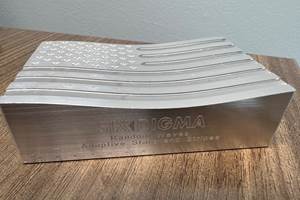Meeting in the Middle
How does industry connect with millennials and introduce them to the high-tech world of modern manufacturing? By seeing beyond differences to what we have in common.
Share





Members of different generations always seem to have problems understanding one another. It was true when my grandparents thought their children had lost their collective minds when they flipped over the Beatles, just as it was when my own parents saw the first Kiss album in my bedroom.
While the music of younger generations is just as perplexing to older folks as it ever was, other challenges exist as well. Everything from how millennials—those who reached young adulthood around the year 2000—communicate with one another via social media, to how they access their news, to how they pursue their entertainment bears absolutely no relation to how these activities were conducted 20 or 30 years ago. And those of us of a certain age seem hopelessly dated to them for our technological ignorance—we’ve all seen that look. So how do we break through this barrier?
Perhaps the first step involves seeing past differences and not making assumptions. Neither is easy. We all tend to see a person’s manner of dressing or presenting themselves to the world as an indication of their inner character, or even their intellect. Sometimes those differences can be so stark as to prevent even making the attempt to reach out—how in the world could that guy and I have anything to talk about? Most of us have friendships that seemed unlikely at first, until something happened that allowed you both to discover what you had in common.
Another might be to try and communicate as a student as well as a teacher. I spoke with a father a while back who was puzzled by his son’s behavior. He didn’t understand his son’s effortless ability to connect with social media, or what he perceived to be a lack of ambition in pinpointing a career path. So he hired his son to work in his gear shop—not to continue his role as provider, but to simply show his son the basic steps involved in holding a job. As it turned out, firsthand experience with the structure and customs of the workplace was exactly what he needed; to watch his dad and his colleagues make their way through the average working day, being forced to communicate directly rather than virtually while collaborating on projects and learning what it means to have responsibilities to other people who are counting on you. Once that framework was established in his son’s mind, he began making suggestions about how to harness social media in marketing the company and pointing out apps that streamlined their work. So the son is now teaching the father, and vice versa, both to the company’s benefit. Could it be as simple as that?
Not completely, but the first step in overcoming differences is talking about them with a clear and open mind. It’s not about trying to sell someone on your particular worldview, but doing the hard work of realizing that people have different perspectives on life. In many ways, it’s our differences that make us interesting, and of the most value to each other.
So the next time you and an acquaintance of a different generation are circling each other cautiously, try dropping your defenses and following your curiosity about this seemingly
alien but nonetheless interesting person. Who knows, they could end up teaching you a thing
or two.
Related Content
How I Made It: Nushrat Ahmed: CNC Swiss Operator
By day, 21-year-old Nushrat Ahmed is a CNC Swiss operator making automotive parts. By night, she handcrafts crocheted items.
Read MoreBuilding Machines and Apprenticeships In-House: 5-Axis Live
Universal machines were the main draw of Grob’s 5-Axis Live — though the company’s apprenticeship and support proved equally impressive.
Read MoreManufacturing Technology and Training in Europe
NTMA’s European Tech Tour exposed attendees to the latest technology and traditional training methods used by European manufacturers.
Read MoreWorkholding Fixtures Save Over 4,500 Hours of Labor Annually
All World Machinery Supply designs each fixture to minimize the number of operations, resulting in reduced handling and idle spindle time.
Read MoreRead Next
AMRs Are Moving Into Manufacturing: 4 Considerations for Implementation
AMRs can provide a flexible, easy-to-use automation platform so long as manufacturers choose a suitable task and prepare their facilities.
Read MoreLast Chance! 2025 Top Shops Benchmarking Survey Still Open Through April 30
Don’t miss out! 91ÊÓƵÍøÕ¾ÎÛ's Top Shops Benchmarking Survey is still open — but not for long. This is your last chance to a receive free, customized benchmarking report that includes actionable feedback across several shopfloor and business metrics.
Read MoreMachine Shop MBA
Making Chips and 91ÊÓƵÍøÕ¾ÎÛ are teaming up for a new podcast series called Machine Shop MBA—designed to help manufacturers measure their success against the industry’s best. Through the lens of the Top Shops benchmarking program, the series explores the KPIs that set high-performing shops apart, from machine utilization and first-pass yield to employee engagement and revenue per employee.
Read More


















